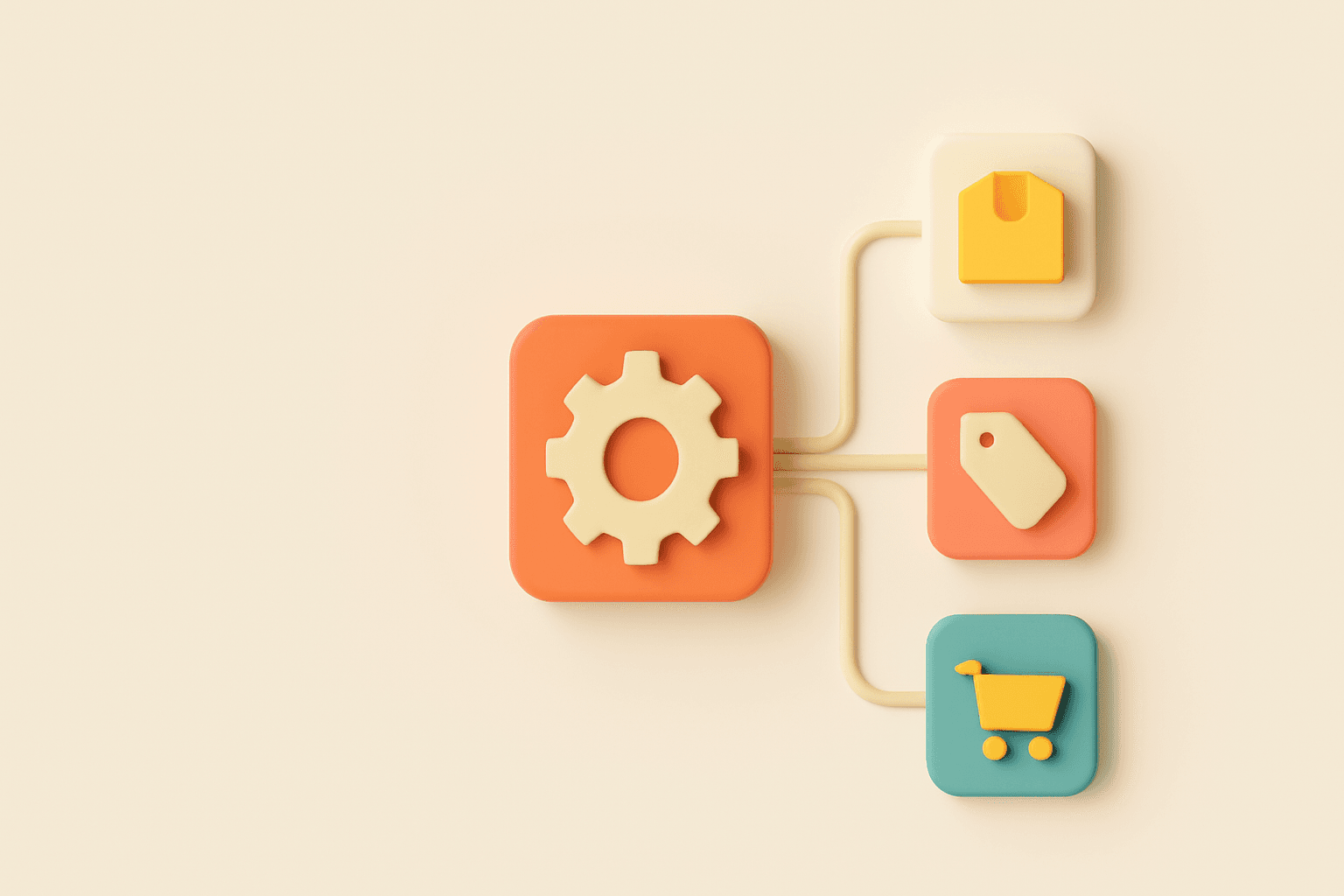B2B ERP Integration Best Practices 2025
B2B ERP integration is a crucial need for manufacturers, wholesalers, and distributors navigating complex sales cycles, multi-stakeholder transactions, and real-time inventory visibility. In 2025, the ability to synchronize ERP systems with digital commerce workflows is what enables seamless PO-to-invoice automation, channel-specific pricing, and scalable backend orchestration.
This playbook explores the best practices for B2B ERP integration, based on real-world patterns observed across large-scale implementations. You’ll learn how to approach data mapping, middleware architecture, and modular rollout strategies—while addressing integration risks like legacy bottlenecks and inconsistent partner data.
Whether you’re modernizing fragmented systems or planning your first enterprise-grade ERP connection, this guide will help you build a roadmap aligned with both operational and commercial goals.
What is B2B ERP Integration and Why It Matters in 2025
B2B ERP integration connects an enterprise’s internal systems with external platforms and stakeholders to automate complex buying processes. Unlike B2C, it supports contract-based workflows, approval chains, multi-tier pricing, and supplier collaboration. In 2025, it’s not just about automation—it’s about enabling scale, speed, and transparency across interconnected supply chains.
Where B2C ERP handles fast, direct transactions, B2B requires deeper coordination across procurement, finance, and operations. The right ERP integration unlocks margin control, fulfillment precision, and buyer-side visibility across channels.
Core Components of B2B ERP Integration
B2B integration demands more than just data sync—it requires orchestration across the entire transaction lifecycle:
-
Order & Contract Management: Capture RFQs, contracts, negotiated terms, and recurring POs.
-
Credit & Payments: Enforce account terms, manage credit limits, and automate invoice matching.
-
Inventory Visibility: Sync stock levels across plants, 3PLs, and supplier warehouses in real time.
-
Partner/Dealer Portals: Allow B2B buyers to self-manage orders, pricing, documents, and fulfillment.
-
Integration Middleware & API Layer: Bridges ERP with CRMs, logistics, and punchout catalogs.
-
EDI Integration: Supports structured document exchange (orders, ASNs, invoices) with legacy partners.
Key Differences Between B2B and B2C ERP Integration
| Features | B2B ERP Integration | B2C ERP Integration |
|---|---|---|
| Buyer Workflow | RFQ, contracts, approvals, negotiated POs | Single-step online checkout |
| Pricing Complexity | Customer-specific pricing, volume discounts | Flat pricing, coupons, seasonal discounts |
| Payment & Invoicing | Credit terms, invoicing, net payment cycles | Prepaid via card or wallet |
| Integration Needs | EDI, partner APIs, punchout catalogs | Webhooks, storefront sync |
| Fulfillment Models | BOLs, split shipments, custom delivery routing | Standard delivery, in-cart tracking |
Top B2B ERP Integration Features for Modern Enterprise Workflows
Modern B2B ERP integration solutions must address complex enterprise requirements with scalable, customizable features supporting sophisticated business processes. Key features include:
Advanced Financial Management Capabilities
B2B financial operations demand robust ERP functionalities to manage intricate financial processes:
-
Multi-Entity Accounting: Support for managing financials across multiple subsidiaries or business units, ensuring compliance and consolidated reporting.
-
Customer-Specific Pricing and Volume-Based Billing: Tailored pricing strategies based on customer contracts and purchase volumes.
-
Invoice-to-PO Reconciliation Workflows: Automated matching of purchase orders to invoices, reducing manual errors and accelerating the accounts payable process.
-
Credit Limits and Aging Reports: Real-time visibility into customer credit limits and aging reports to manage receivables effectively.
-
AR/AP Visibility Across Regions: Comprehensive accounts receivable and payable tracking across different geographical regions.
In 2024, NetSuite introduced enhanced invoice automation features, enabling businesses to streamline invoice reconciliation and data synchronization across financial and supply chain management systems.
Inventory and Supply Chain Management
Efficient inventory and supply chain management are critical for B2B enterprises:
-
Real-Time Inventory Synchronization: Continuous updates across multiple warehouses, suppliers, and third-party logistics providers to maintain accurate stock levels.
-
Just-In-Time (JIT) Inventory Logic: Minimizing inventory holding costs by receiving goods only as needed for production.
-
Automated Reorder Thresholds: System-triggered reorder points based on historical data and demand forecasting.
-
Integrated Logistics Partner APIs: Seamless communication with logistics partners for tracking and managing shipments.
B2B Customer Relationship Management
B2B CRM within ERP systems must handle complex customer relationships:
-
Hierarchical Account Structures: Managing parent-child relationships among corporate clients for better account oversight.
-
Contract History and Credit Tracking: Maintaining detailed records of customer contracts and credit statuses.
-
Sales Rep Assignment and Commission Logic: Assigning sales representatives to accounts and calculating commissions based on sales performance.
-
Dealer and Distributor Portal Integration: Providing partners with access to order histories, pricing, and product information.
Multi-channel Order Processing
Handling orders from various channels requires integrated ERP capabilities:
-
Consolidation of Orders: Aggregating orders from EDI, punchout catalogs, B2B portals, and traditional methods like email or fax.
-
Integration with Procurement Platforms: Seamless syncing with platforms such as Ariba and Coupa.
-
Routing Logic Based on SLAs: Directing orders to appropriate warehouses based on service level agreements and proximity.
-
Split Shipments and Backorder Workflows: Managing partial shipments and backorders efficiently.
B2B ERP Integration Methods and Approaches
Choosing the right B2B ERP integration method is critical to ensuring scalability, data accuracy, and cross-platform performance. The method you choose will affect setup speed, system flexibility, and long-term maintenance. Below are three key considerations:
Custom vs. Pre-built Integration Solutions
Custom integrations are essential when working with legacy ERP systems, proprietary workflows, or complex pricing and PO-to-invoice reconciliation logic. They allow:
-
Full control over data mapping, workflows, and middleware logic.
-
Custom-built APIs and integrations aligned to business-specific SLAs.
Risks: Higher time to market, resource-intensive development, long-term maintenance overhead.
If your ERP serves multi-brand B2B catalogs or contract-specific workflows, custom APIs may be necessary.
Pre-built connectors, on the other hand, are ideal for cloud-native ERPs like NetSuite, Dynamics 365, or Acumatica, where fast go-live timelines are critical. Middleware platforms like Celigo, Boomi, and Jitterbit provide out-of-the-box connectors for systems like Salesforce, Shopify Plus, and Adobe Commerce.
Risks: Limited customization, potential vendor lock-in with connector updates.
Cloud-based vs. On-premise Integration
Cloud-based integration is API-first by design and ideal for composable or hybrid tech stacks. These systems support real-time communication between ERPs and external systems through platforms like MuleSoft, Cleo, or Workato.
Use case: Integrating NetSuite ERP with a B2B DXP using Celigo or MuleSoft for real-time updates.
On-premise ERP integration is still common in manufacturing, logistics, and pharma. These setups often rely on:
-
SFTP-based data transfer,
-
Flat-file exchange,
-
VPN-secured middleware layers.
Use case: Syncing SAP ECC with legacy warehouse systems using nightly SFTP batch jobs.
Hybrid models are the norm for many B2B enterprises. Example: On-prem ERP with a cloud-native B2B storefront or procurement platform.
Hybrid ERP stacks require strong tokenization and role-based access controls (RBAC) to avoid exposing legacy systems to public endpoints.
Real-time vs. Batch Processing Options
The choice between real-time and batch integration depends on business function, urgency, and infrastructure readiness.
| Method | Best Use Case | Pros | Risks |
|---|---|---|---|
| Real-time | Order status, inventory, credit availability | Up-to-date accuracy, better CX | Higher infrastructure cost, more complexity |
| Batch | Master data updates, financial summaries | Lightweight, stable for ERP core systems | Delays in reflecting changes |
-
Real-time integrations use event-driven architecture (Kafka, RabbitMQ) or webhook-based APIs. Ideal for fast-changing data: order routing, live pricing, stock sync.
-
Batch processing is still effective for scheduled data updates: product catalog syncs, aged receivables, or report generation.
Tip: For large-scale B2B enterprises, a combination of both methods—real-time for transactional data and batch for reporting—provides the best balance between performance and maintainability.
Common Integration Challenges and Solutions
Smooth B2B ERP integration depends on how well your systems handle data consistency, legacy infrastructure, and high-volume performance. Below are the top challenges enterprise teams face—and how to solve them.
Data Management and Synchronization
Inconsistent data across systems leads to issues like SKU mismatches, pricing errors, and failed invoice reconciliation. These problems worsen at scale, especially when syncing data between ERP systems and external platforms like customer portals or DXP frontends.
Common pitfalls include:
-
Different product naming conventions across ERP and storefronts
-
Pricing tier conflicts across customer accounts
-
Currency or invoice format mismatches in cross-border transactions
-
Duplicate orders from misaligned real-time and batch sync cycles
Solutions:
-
Implement a master data management (MDM) layer to unify product, pricing, and account data
-
Use ETL pipelines or middleware (e.g., Boomi, Jitterbit) for validation and transformation
-
Enable timestamp-based sync protocols to prioritize the most recent updates and prevent duplication
Legacy System Integration
Many enterprise B2B operations still rely on legacy systems like SAP ECC, Oracle EBS, or AS/400, which lack modern APIs or cloud-readiness. These systems often use flat files or FTP-based data exchanges, increasing manual intervention and reducing real-time visibility.
Solutions:
-
Use middleware platforms like MuleSoft, Boomi, or Jitterbit to act as API bridges
-
Wrap legacy systems with custom API adapters to expose key endpoints
-
Stage legacy ERP data in cloud-hosted integration environments for read/write access without interrupting core systems
Scalability and Performance Issues
As product SKUs, customer orders, and partner systems grow, so do the demands on your integration pipeline. Poor throughput can delay order confirmations, misroute shipments, and reduce system reliability.
Common issues include:
-
Slow batch jobs during peak order volumes
-
Delays syncing SKUs, inventory, and pricing across geographies
-
API throttling during multi-region expansion
Solutions:
-
Adopt event-driven architecture (e.g., Kafka, webhook triggers) to scale data sync horizontally
-
Implement caching on read-heavy endpoints like product catalogs or customer pricing
-
Monitor system health using observability tools like New Relic, Datadog, or Splunk
Target key metrics:
-
<1 second latency per sync event
-
<0.5% error rate across high-volume workflows
Quick Reference: Challenge–Solution Matrix
| Challenge | Example | Solution |
|---|---|---|
| Data sync delays | SKU mismatch between ERP & DXP | MDM + timestamp-based APIs |
| Legacy ERP with no API support | Oracle EBS can’t connect to Shopify | Middleware + API adapters |
| Slow integration at scale | PO sync fails during sales peak | Event-driven queues + caching |
B2B ERP Integration Implementation Guide
A successful ERP integration in B2B is a coordinated, cross-functional transformation. This section breaks down a high-stakes enterprise rollout into its essential stages, with clear guardrails for risk, visibility, and long-term alignment.
Pre-implementation Planning
This is where most B2B ERP integrations either succeed or stall. Aligning business, technical, and operational layers before a single API call is made is non-negotiable.
Pre-integration Checklist:
-
Align ERP goals with sales ops, finance, CX, supply chain
-
Map order-to-cash and quote-to-invoice processes
-
Conduct a data audit: owners, formats, gaps, readiness
-
Budget with a 15–20% buffer for change orders and edge cases
-
Identify interdependencies (legacy systems, regional variations)
-
Validate infrastructure readiness: security, middleware, APIs
📌 Tip: If your ERP data model can't mirror how your sales team handles contracts or pricing tiers, it’s a blocker—not a backend issue.
Stakeholder Management and Training
Technical integration often succeeds. Adoption fails when people are left behind.
What drives ERP adoption in B2B:
-
Early buy-in from business owners—not just IT
-
Role-based onboarding for teams: Sales, Finance, Ops, CX, Warehouse
-
Appoint ERP champions to lead training within each department
-
Create internal process documentation before go-live—not after
-
Handoff ownership from system integrators to internal teams
Testing and Deployment Strategies
Don’t just test integrations—stress-test your workflows. Here’s what a B2B-ready test phase includes:
Integration Tests:
-
Sync quote approvals, PO-to-invoice handoffs, and pricing tiers
-
End-to-end testing across EDI, punchout, and internal portals
-
Test order routing logic under 2x peak season volume
-
Set failure thresholds: e.g., <0.1% failed transactions, <1s latency per sync
| Phase | Duration | Key Focus |
|---|---|---|
| Discovery + Mapping | 2–4 weeks | Process mapping, stakeholder alignment |
| Pilot Integration | 3–6 weeks | Low-risk modules (finance, POs, quotes) |
| UAT & Parallel Testing | 2–3 weeks | Live-data sync, peak load validation |
| Full Deployment | 1–2 weeks | Final cutover + rollback readiness |
| Post-Launch Optimization | Ongoing | Sync monitoring, user feedback loops |
📌 Never go big-bang unless your team can support 24/7 fallbacks for finance, order sync, and reconciliation.
Ready to Plan Your ERP Integration?
Whether you're integrating NetSuite with Salesforce Commerce or modernizing SAP for B2B marketplaces, the right blueprint makes or breaks the rollout. At Coderapper, we specialize in enterprise-grade ERP integrations—built around your workflows, not vendor templates.
👋 Let’s simplify the complex. Reach out at hello@coderapper.com to kick off your ERP roadmap.




![Ecommerce ERP Integration: Complete Playbook [2025]](/static/e15df178f091dadfb4777d21cf818eda/55a7a/ERP_and_Ecommerce_Integration_8fddaa6a45.png)

